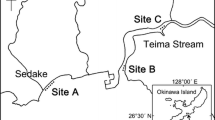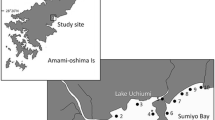Abstract
To determine the growth performances and habitat characteristics of spotted halibut Verasper variegatus, successive samplings were conducted in the south-eastern coastal area of Shimabara Peninsula in Ariake Bay. The push-net samplings were performed at Kamaga beach from May 2003 to April 2004 to determine the horizontal distribution of larvae and juveniles, while the gill net samplings were done in the coastal waters of Tatsuishi beach from July 2003 to July 2004 to collect the larger juveniles and adults. A total of 478 individuals from metamorphosing larvae to 2-year-old fish (15.2–447.0 mm total length [TL]) were sampled. In particular, the 2003-year class fish were successively collected from May 2003 to June 2004 (15.2–350.0 mm TL; n=418) and the mean total length in March, June, September, December 2003 and May 2004 was 22.4, 82.5, 172.5, 203.9 and 296.4 mm, respectively. The present study found that metamophosing larvae migrated into the estuarine tidal flats during March 2003; newly settled juveniles inhabited the shallow intertidal areas; and juveniles had a remarkably high growth in shallow coastal areas. It is suggested that young fish around 300 mm TL migrated from the nursery grounds in Ariake Bay to deeper waters around Tachibana Bay during May–June 2004.
Similar content being viewed by others
References
Anonymous. Spotted Halibut Sea Farming Technology Development and Promotion Report. Japan Sea Farming Association Report 81. Japan Sea Farming Association, Tokyo. 2002.
Ortega-Villaizan RM, Nakajima M, Taniguchi N. Isolation and characterization of microsatellite DNA markers in the rare species barfin flounder (Verasper moseri) and its closely related species spotted halibut (V. variegatus). Mol. Ecol. Notes 2003; 3: 629–631.
Ortega-Villaizan, RM. Comparative study of the rare species barfin flounder (Verasper moseri) with its closely related species spotted halibut (V. variegatus), on the genetic monitoring of the stock enhancement program. PhD Thesis. Tohoku University, Sendai. 2005.
Nemoto Y, Fujita T, Watanabe M. Studies on spotted halibut (Verasper variegatus Temminck & Schlegel): 1. Bull. Fukushima Pref. Fish. Exp. Stat. 1999; 8: 5–16.
Ando M, Niho H, Tsukamasa Y, Makinodan Y. Valuation of cultured spotted halibut Verasper variegatus by comparing with cultured plaice Paralichthys olivaceus. Nippon Suisan Gakkaishi 1998; 64: 1027–1033.
Tsuzaki T. Present status and problems of seedling production of spotted halibut, Verasper variegatus. Suisanzoshoku 1995; 43: 273–276.
Imamura K. The organization and development of sea farming in Japan. In: Howell BR, Moksness E, Svåsand T (eds), Stock Enhancement and Sea Ranching. Blackwell Science, London. 1999; 91–102.
Kitada S. Effectiveness of Japan’s stock enhancement programs: current perspectives. In: Howell BR, Moksness E, Svåsand T (eds). Stock Enhancement and Sea Ranching. Blackwell Science. London. 1999; 103–131.
Tanaka M, Seikai T, Yamamoto E, Furuta S. Significance of larval and juvenile ecophysiology for stock enhancement of the Japanese flounder Paralichthys olivaceus. Bull. Mar. Sci. 1998; 62: 551–571.
Takita T, Fujita S, Dotsu Y. Egg development and prolarval stages of flat fish, Verasper variegatus (Temminck et Schlegel). Bull Fac. Fish., Nagasaki Univ. 1967; 23: 101–106.
Aritaki M, Ohta K, Hotta Y, Tanaka M. Morphological development and growth of laboratory-reared spotted halibut Verasper variegatus. Nippon Suisan Gakkaishi 2001; 67: 58–66.
Aritaki M, Ohta K, Hotta Y, Tagawa M, Tanaka M. Temperature effects on larval development and occurrence of metamorphosis-related morphological abnormalities in hatchery-reared spotted halibut Verasper variegatus juveniles. Nippon Suisan Gakkaishi 2004; 70: 8–15.
Hotta Y, Aritaki M, Ohta K, Tagawa M, Tanaka M. Development of the digestive system and metamorphosis relating hormones in spotted halibut larvae and early juveniles. Nippon Suisan Gakkaishi 2001; 67: 40–48.
Hotta Y, Aritaki M, Tagawa M, Tanaka M. Changes in tissue thyroid hormone levels of metamorphosing spotted halibut Verasper variegatus reared at different temperatures Fish. Sci. 2001; 67: 1119–1124.
Hotta Y, Aritaki M, Tagawa M, Tanaka M. Early life history of spotted halibut Verasper variegatus: metamorphosis and settlement analyzed by laboratory experiments. Saibai Giken 2001; 29: 59–72.
Wada T, Aritaki M, Tanaka M. Effects of low-salinity on the growth and development of spotted halibut Verasper variegatus in the larva-juvenile transformation period with reference to pituitary prolactin and gill chrolide cells responses. J. Exp. Mar. Biol. Ecol. 2004; 308: 113–126.
Uchida K. Metamorphic stages of the flatfishes of Japan. II. Verasper variegatus. Zool. Mag. 1933; 45: 268–277.
Minami T, Nakamura I. Seasonal occurrence of pelagic stages of flatfishes (Pleuronectiformes) in the coastal waters of western Wakasa Bay, the Japan Sea. Mem. Coll. Agr. Kyoto Univ. 1978; 112: 29–47.
Noichi T, Subiyanto, Kambara T, Senta T. The occurrence of spotted halibut larvae juveniles in the sandy beaches at western Kyushu region. In: Abstract for the annual meeting of the Japanese Society of Fisheries Science. Japanese Society of Fisheries Science, Tokyo. 1991; 36.
Nakamura R, Yamada A, Terui M. Seeding of artificial juveniles of spotted halibut (Verasper variegatus (Temminck et Schlegel) in Tokyo Bay. Bull. Kanagawa Pref. Fish. Res. Inst. 1997; 2: 55–63.
Nakamura R, Yamada A. Seeding of hatchery produced juveniles of spotted halibut (Verasper variegatus (Temminck et Schlegel) in Tokyo Bay: II. Growth and migration after release and estimating effects of seeding. Bull. Kanagawa Pref. Fish. Res. Inst. 1999; 4: 27–36.
Shiraishi K. The feeding habit of the spotted halibut Verasper variegatus which was released in Shizugawa Bay, Miyagi Prefecture. Suisanzoshoku 2003; 51: 119–120.
Amarullah MH, Senta T. The R-H push-net, a gear for study of juvenile flatfishes along the beach. Bull. Fac. Fish. Nagasaki Univ. 1989; 65: 9–14.
Inoue N. Physical environments of Ariake Bay. In: Aoyama T, Kamata Y, Ikematsu W, Takita T, Inoue N, Shirota A, Hirota R (eds). Ariake Bay, Kaiyo Monthly 1980; 124: 116–126.
Solomon G, Sano M, Shimizu M, Nose Y. Age and growth of the Pleuronectid flounder Limanda yokohanae in Tokyo Bay, Japan. Nippon Suisan Gakkaishi 1987; 53: 711–716.
Uehara S, Shimizu M. Age and growth of stone flounder Kareius bicoloratus in Tokyo Bay, Japan. Fish. Sci. 1996; 62: 897–901.
Yamaguchi S, Yoneda M, Ohta K, Miyaki K, Arakawa T, Matsuyama M. Reproductive biology of spotted halibut, Verasper variegatus, in Tachibana Bay, Nagasaki Prefecture. Sci. Bull. Fac. Agr. Kyushu Univ. 2001; 55: 179–184.
Mito S. Pelagic fish eggs from Japanese waters: IX. Echeneida and Pleuronectida. Jpn. J. Ichthyol. 1963; 11: 81–102.
Tanaka M, Goto T, Tomiyama M, Sudo H, Azuma M. Lunar-phased immigration and settlement of metamorphosing Japanese flounder larvae into the nearshore nursery ground. Rapp. P. V. Réun. Cons. Int. Explor. Mer. 1989; 191: 303–310.
Burke JS, Ueno M, Tanaka Y, Walsh H, Maeda T, Kinoshita I, Seikai T, Hoss DE, Tanaka M. The influence of environmental factors on early life history patterns of flounders. J. Sea Res. 1998; 40: 19–32.
Yamashita Y, Tsuruta Y, Yamada H. Transport and settlement mechanisms of larval stone flounder, Kareius bicoloratus, into nursery grounds. Fish. Oceanogr. 1996; 5: 194–204.
Gibson RN. Behavior and the distribution of flatfishes. J. Sea Res. 1997; 37: 241–256.
Forward RB, Tankersley RA. Selective tidal-stream transport of marine animals. Oceanogr. Mar. Biol. Annu. Rev. 2001; 39: 305–353.
Van der Veer HW, Bergman MJH. Development of tidally related behavior of a newly settled 0-group plaice (Pleuronectes platessa L.) population in the western Wadden Sea. Mar. Ecol. Prog. Ser. 1986; 31: 121–129.
Van der Veer HW, Dapper R, Witte JIJ. The nursery function of the intertidal areas in the western Wadden Sea for 0-group sole Solea solea (L.). J. Sea. Res. 2001; 45: 271–279.
Gibson RN, Robb L, Wennhage H, Burrows MT. Ontogenetic changes in depth distribution of juvenile flatfishes in relation to predation risk and temperature on a shallow-water nursery ground. Mar. Ecol. Prog. Ser. 2002; 229: 233–244.
Malloy KD, Yamashita Y, Yamada H, Targett TE. Spatial and temporal patterns of juvenile stone flounder Kareius bicoloratus growth rates during and after settlement. Mar. Ecol. Prog. Ser. 1996; 131: 49–59.
Yamashita Y, Otake T, Yamada H. Relative contributions from exposed inshore and estuarine nursery grounds to the recruitment of stone flounder, Platichthys bicoloratus, estimated using otolith Sr: Ca ratios. Fish. Oceanogr. 2000; 9: 316–327.
Yamashita Y, Tominaga O, Takami H, Yamada H. Comparison of growth, feeding and cortisol level in Platichthys bicoloratus juveniles between estuarine and nearshore nursery grounds. J. Fish Biol. 2003; 63: 617–630.
Minami T, Tanaka M. Life history cycles in flatfish from the northwestern pacific, with particular reference to their early life histories. Neth. J. Sea Res. 1992; 29: 35–48.
Ochiai A, Tanaka M. Paralichthyidae and Pleuronectidae. In: Ochiai A (ed.). Gyorui gaku (Ichthyology). Kouseishakouseikaku. Tokyo, 1986; 1072–1118.
Atsuchi S, Masuda Y, Akamo H, Iori K. Age and growth of Japanese flounder Paralichthys olivaceus from the coastal waters around Kagoshima Prefecture, Japan, using transverse sections of otoliths. Nippon Suisan Gakkaishi 2004; 70: 714–721.
Madon SP. Ecophysiology of juvenile California halibut Paralichthys californicus in relation to body size, water temperature and salinity. Mar. Ecol. Prog. Ser. 2002; 243: 235–249.
Author information
Authors and Affiliations
Corresponding author
Rights and permissions
About this article
Cite this article
Wada, T., Mitsunaga, N., Suzuki, H. et al. Growth and habitat of spotted halibut Verasper variegatus in the shallow coastal nursery area, Shimabara Peninsula in Ariake Bay, Japan. Fish Sci 72, 603–611 (2006). https://doi.org/10.1111/j.1444-2906.2006.01190.x
Received:
Accepted:
Issue Date:
DOI: https://doi.org/10.1111/j.1444-2906.2006.01190.x




